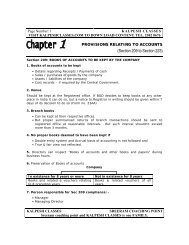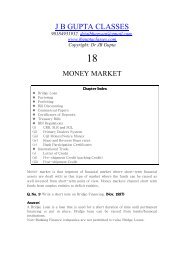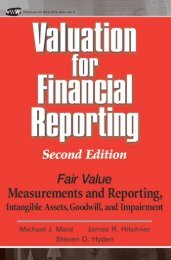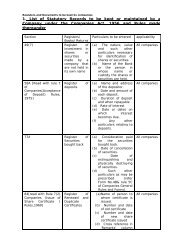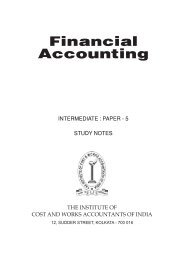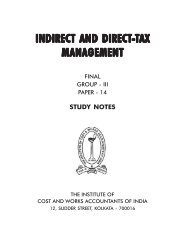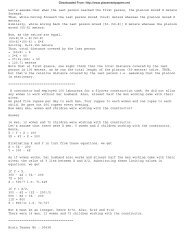Chapter 6 Chapter 6
Chapter 6 Chapter 6
Chapter 6 Chapter 6
You also want an ePaper? Increase the reach of your titles
YUMPU automatically turns print PDFs into web optimized ePapers that Google loves.
49<br />
(a) Let YTM = r<br />
260(1+r) 8 = 1000<br />
(1+r) 8 = 3.8462<br />
1+r = 1.1834 r = 18.34%<br />
(b) Let the market price = x<br />
x(1.15) 12 = 1000 x = 186.91<br />
(c) PV of rupee one to be received on maturity ( at 10%) = 0.218<br />
Consulting the PVF table, we find that this holds when the maturity is 16 years.<br />
Q. No. 64: The following is the list of prices of zero coupon bonds of various<br />
maturities.<br />
Maturity (years).<br />
Market price of Rs.1000 face value bond<br />
1 Rs.952.38<br />
2 Rs.890.00<br />
3 Rs.816.30<br />
What are the forward rates for year 2, and 3<br />
Answer<br />
Calculation of forward rates using the basic concept of valuation<br />
Year 1 : 952.38(1+r) = 1000<br />
r = 5%<br />
Year 2 : 890(1.05)(1+r) = 1,000<br />
r = 7.0095%<br />
Year 3 : 816.30(1.05)(1.070095)(1+r) = 1,000<br />
r = 9.03%<br />
THEORETICAL ASPECTS<br />
Q.65: What is interest rate risk, reinvestment risk and default risk & what are the<br />
types of risk involved in investment in G-sec. ( Nov. 2005)<br />
Answer: The term risk is used to denote the possibility of variability in the<br />
returns expected from the investment i.e. the actual return differs from the<br />
expected one. Investment in bonds is not entirely risk free. Both systematic and<br />
unsystematic risks are associated with the investment in bonds.<br />
Default Risk : The issuer may default in the payment of interest or principal or<br />
both on the stipulated dates. This risk is referred as Unsystematic risk of Bond<br />
Investments.



